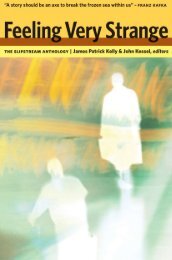The Curse of the Wer.. - Site de Thomas - Free
The Curse of the Wer.. - Site de Thomas - Free
The Curse of the Wer.. - Site de Thomas - Free
Create successful ePaper yourself
Turn your PDF publications into a flip-book with our unique Google optimized e-Paper software.
56 THE CURSE OF THE WEREWOLF<br />
with <strong>the</strong> mind. In<strong>de</strong>ed, <strong>the</strong> male werewolf’s psychic suffering frequently<br />
guaranteed his eventual salvation, whereas <strong>the</strong> <strong>de</strong>monic female werewolf<br />
was always <strong>de</strong>stroyed. Maturin’s lycanthrope, for example, returns<br />
to lucidity on his <strong>de</strong>athbed, and obtains forgiveness for his sins. Wagner<br />
<strong>the</strong> Wehr-Wolf is <strong>the</strong> unfortunate and unwilling victim <strong>of</strong> a curse (he<br />
had, in fact, brought his curse upon himself by striking a bargain with<br />
Faust, but has <strong>the</strong> <strong>de</strong>cency to regret it). He dies, but only after he has<br />
re<strong>de</strong>emed himself in <strong>the</strong> eyes <strong>of</strong> God. Thibault, a werewolf created by<br />
Alexandre Dumas, meets a very similar fate to Wagner; after years <strong>of</strong><br />
unhappiness as a result <strong>of</strong> his bargain with evil, he <strong>of</strong>fers his life so<br />
that <strong>the</strong> woman he loves may live, and his soul is saved. 39 Stenbock’s<br />
werewolf Gabriel is rescued by a <strong>de</strong>vout priest, and Rudyard Kipling’s<br />
Fleete, although he capitulates entirely to <strong>the</strong> curse <strong>of</strong> an Indian<br />
leper and is soon found ‘on his hands and knees un<strong>de</strong>r <strong>the</strong> orange<br />
bushes’, is saved by his loyal friends, who capture <strong>the</strong> leper and force<br />
him to remove <strong>the</strong> curse. 40 Overwhelmingly in such fiction, <strong>the</strong> man<br />
who succumbed to atavistic urges could, with a little discipline, still<br />
attain salvation or transcen<strong>de</strong>nce, while his more corporeally impe<strong>de</strong>d<br />
female counterpart was irrevocably lost to primal nature and would<br />
be returned to <strong>the</strong> earth whence she came.<br />
Male werewolves could also be excused on <strong>the</strong> grounds <strong>of</strong> insanity,<br />
as in <strong>the</strong> case <strong>of</strong> Maturin’s werewolf, who <strong>de</strong>clared himself to be ‘Mad,<br />
ay! that is it: I am a mad wolf.’ 41 As Sally Shuttleworth notes, early<br />
<strong>the</strong>orizations <strong>of</strong> mental illness had emphasized ‘<strong>the</strong> animal nature<br />
<strong>of</strong> <strong>the</strong> insane’, 42 and an association between werewolves and insanity<br />
can be traced to <strong>the</strong> earliest medical treatises on lycanthropy. Psychologized<br />
representations <strong>of</strong> lycanthropy in <strong>the</strong> nineteenth century<br />
<strong>de</strong>veloped out <strong>of</strong> this tradition <strong>of</strong> associations, and kept pace with a<br />
shift in attitu<strong>de</strong> towards mental illness that had been ga<strong>the</strong>ring force<br />
since <strong>the</strong> Enlightenment. As belief in witchcraft or diabolical possession<br />
subsi<strong>de</strong>d, symptoms that had once been associated with such<br />
phenomena were now reinterpreted within a scientific framework as<br />
signs <strong>of</strong> mental illness, to be treated ra<strong>the</strong>r than punished. 43 By <strong>the</strong><br />
time <strong>the</strong> Lunatic Acts <strong>of</strong> 1845 were passed, insanity was no longer<br />
conflated with criminality. 44





